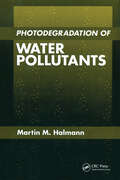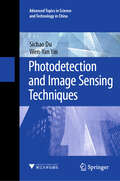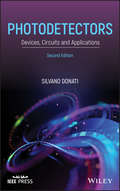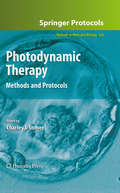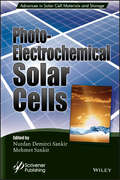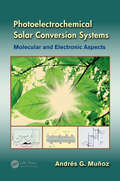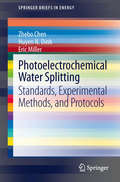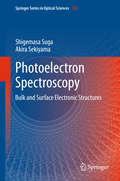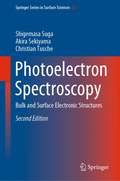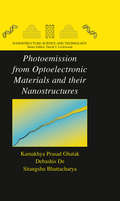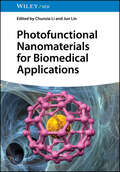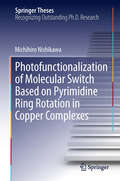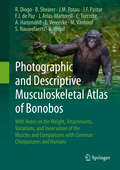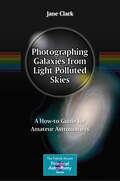- Table View
- List View
Photodegradation of Water Pollutants
by Martin M. HalmannPhotodegradation of Water Pollutants, the only complete survey available of current photocatalytic methods for treating water pollutants, covers all aspects of light-stimulated detoxification. Ideal for researchers and students, this new book explains methods for pollution treatment that have proven more effective than conventional biodegradation.Photodegradation of Water Pollutants examines advanced oxidation processes that have been successful in treating the chemical substances produced by industrial effluents and intensive agriculture. These oxidation processes include irradiation with ultraviolet or visible light, the use of homogenous sensitizers, such as dyes, and the use of heterogeneous photocatalysts, such as dispersed semiconductors. In addition, Photodegradation of Water Pollutants addresses the naturally occurring self-cleaning of some pollutants in sunlit surface waters, as well as several alternative non-photochemical approaches to water treatment. Available treatment options are discussed for the main groups of water pollutants, including toxic inorganic ions (cyanides, heavy metals), hydrocarbon derivatives (oil spills, surfactants, pulp and paper wastes), halocarbons, organo-N, organo-P, and organo-S compounds. The text also contains a unique section on the economics of advanced oxidation pollution treatments.
Photodetection and Image Sensing Techniques (Advanced Topics in Science and Technology in China #2)
by Sichao Du Wen-Yan YinThis book provides a comprehensive and systematic introduction to optoelectronic imaging techniques. Starting from the basis of photoelectric detection technology, it thoroughly discusses the basic knowledge of radiation measurement and light metrics, the basic principles of semiconductors, and the basic physical effects and characteristic parameters of photoelectric detection devices. It further introduces the types and characteristics of light sources commonly used in photoelectric detection. This lays a solid foundation for readers to learn the single photon detector, single photon imaging technology, and spectral imaging technology. This book also details the working principle, classification characteristics, and performance evaluation method of single-photon detectors, as well as the applications in low-light detection and quantum communication. Spectral imaging technology and two-dimensional imaging technology are also explained in terms of basic principles, system classification and characteristics. It also focuses on the practical applications of photoelectric detection technology in various fields, including remote sensing, atomic absorption spectroscopy analysis, mechanical quantity detection, etc., showing the wide application and great potential of photoelectric detection technology through specific cases. The frontiers and development trends of optoelectronic imaging technology are discussed, revealing the future development direction and challenges in this field for the readers.
Photodetectors: Devices, Circuits and Applications
by Silvano DonatiExplore this comprehensive introduction to the foundations of photodetection from one of the leading voices in the field The newly revised Photodetectors: Devices, Circuits and Applications delivers a thoroughly updated exploration of the fundamentals of photodetection and the novel technologies and concepts that have arisen since the release of the first edition twenty years ago. The book offers discussions of established and emerging photodetection technologies, including photomultipliers, the SPAD, the SiPM, the SNSPD, the UTC, the WGPD/TWPD, the QWIP, and the LT-GaAs. New examinations of correlation measurements on ultrafast pulses and single-photon detectors for quantum communications and LiDARs have also been added. Each chapter includes selected problems for students to work through to aid in learning and retention. A booklet of solutions is also provided. The book is especially ideal for students and faculties of Engineering, with an emphasis on first principles, design, and the engineering of photodetectors. Issues in the book are grouped through the development of concepts, as opposed to collections of technical details. Perfect for undergraduate students interested in the science or design of modern optoelectronics, Photodetectors: Devices, Circuits and Applications also belongs on the bookshelves of professors teaching PhD seminars in advanced courses on photodetection and noise, as well as engineers and physicists seeking a guide to an optimum photodetection solution.
Photodynamic Therapy
by Charles J. GomerBiological interactions of visible light with photosensitizers have been studied for over a century while controlled clinical applications of light and photosensitizers to treat solid tumors, known as photodynamic therapy, have been evolving since the mid 1970's. In Photodynamic Therapy: Methods and Protocols, leading PDT scientists and clinicians provide the first comprehensive collection of methods and protocols specifically related to relevant mechanistic, dosimetric, preclinical, and clinical procedures used in current PDT research. Reflecting the growing number of studies demonstrating that immunological, tumor microenvironmental, and vascular responses are all contributing to PDT treatment outcomes, the contents of this volume move beyond the more traditional PDT concepts in order to investigate the numerous signal transduction and cell death pathways involved. Written in the highly successful Methods in Molecular BiologyTM series format, chapters include introductions to their respective topics, lists of the necessary materials and reagents, step-by-step, readily reproducible laboratory protocols, and notes which highlight tips on troubleshooting and avoiding known pitfalls. Authoritative and cutting-edge, Photodynamic Therapy: Methods and Protocols is an ideal guide for new investigators just starting out in PDT research as well as seasoned investigators changing the direction of their research with the intention of exploring this vital field of study.
Photodynamic Therapy: Basic Principles and Clinical Applications
by Barbara W. HendersonCovering all aspects of photodynamic therapy, 70 expert contributors from the fields of photochemistry, photobiology, photophysics, pharmacology, oncology and surgery, provide multidisciplinary discussions on photodynamic therapy - a rapidly-developing approach to the treatment of solid tumours.;Photodynamic Therapy: Basic Principles and Clinical Applications describes the molecular and cellular effects of photodynamic treatment; elucidates the complex events leading to photodynamics tissue destruction, particularly vascular and inflammatory responses; discusses the principles of light penetration through tissues and optical dosimetry; examines photosensitizer pharmacology and delivery systems; reviews in detail photosensitizer structure-activity relationships; illustrates novel devices that aid light dosimetry and fluorescence detection; and extensively delineates clinical applications, including early diagnosis and treatment.;A comprehensive and up-to-date reference, this book should be useful for oncologists, pharmacologists, surgeons, photobiologists, optical engineers, laser technicians, biologists, physicists, chemists and biochemists involved in cancer research, as well as graduate-level students in these disciplines.
Photodynamic Therapy: Methods and Protocols (Methods in Molecular Biology #2451)
by Hong Zhang Michael R. Hamblin Mans Broekgaarden Mladen Korbelik Michal HegerThis collection explores state-of-the-art methods and protocols for research on photodynamic therapy (PDT) and its use in a wide range of medical applications, from antiviral to anticancer. Beginning with an extensive section on in vitro and in vivo models, the volume continues with chapters on oxygen-independent photosensitizers, next-generation photosensitization strategies, contemporary insights into the immunomodulatory effects of PDT, antimicrobial effects of PDT, as well as a variety of general biochemical and molecular biological techniques. Written for the highly successful Methods in Molecular Biology series, chapters include the kind of detailed implementation advice that ensures successful results in the lab. Thorough and authoritative, Photodynamic Therapy: Methods and Protocols serves as an ideal source of inspiration for both new and established PDT scientists and a guide for designing innovative research programs in this continuously advancing and multidisciplinary field.
Photoelectric Detection on Derived Attributes of Targets
by Yihua Hu Xing YangThis book highlights the novel photoelectric detection technique on derived attributes of targets. Photoelectric detection on derived attributes of targets is a new target detection and monitoring method. It is achieved by acquiring three types of attributes of the target, including those that reflect the essential features of parts of the target, those directly generated from the target, and those synthesized by the target features. The book introduces the classification of derived attributes of targets and describes typical detection methods. Emphases are put on laser detection of aerial moving targets, using derived attributes such as the disturbance of atmospheric wind fields, trailing vortexes, and the disturbance of atmospheric components. The authors also elaborate on visible light imaging detection using derived attributes such as retroreflection and the identification of target carriers. Besides, the synthetic attributes processing of integrated aerospace images is introduced for the detection of targets on the ground and sea surfaces. This book can be used as a good reference for researchers engaged in the fields of photoelectric detection, target detection and image processing, and as a reference book for senior undergraduates and postgraduates in relevant majors.
Photoelectrochemical Generation of Fuels (Emerging Materials and Technologies)
by Anirban DasPhotoelectrochemical processes due to the symbiosis of photochemical and electrochemical processes result in unique reaction pathways and products. This technique catalysed by nanomaterials is extensively used to harness sunlight for production of fuels and chemical feedstocks. This book explains the basic concepts of photoelectrochemistry as well as their application in the generation of solar fuels from water, CO2 and N2 as feedstocks. It also contains standard methodologies and benchmarks of fuel production including current state of the art in nanocatalysts as well as their mechanism of action. This book: Explores fundamentals and real-time applications of photoelectrochemistry in fuel generation Reviews basic theory and best-known catalysts and best conditions/processes for fuel generation in each of the chapters Covers standard methodologies, processes, and limitations for large-scale applications Focusses on sustainable production of fuels from renewable energy and resources This book aims at graduate students/researchers in chemical, energy and materials engineering.
Photoelectrochemical Hydrogen Production
by Roel van de Krol Michael GrätzelPhotoelectrochemical Hydrogen Production describes the principles and materials challenges for the conversion of sunlight into hydrogen through water splitting at a semiconducting electrode. Readers will find an analysis of the solid state properties and materials requirements for semiconducting photo-electrodes, a detailed description of the semiconductor/electrolyte interface, in addition to the photo-electrochemical (PEC) cell. Experimental techniques to investigate both materials and PEC device performance are outlined, followed by an overview of the current state-of-the-art in PEC materials and devices, and combinatorial approaches towards the development of new materials. Finally, the economic and business perspectives of PEC devices are discussed, and promising future directions indicated. Photoelectrochemical Hydrogen Production is a one-stop resource for scientists, students and R&D practitioners starting in this field, providing both the theoretical background as well as useful practical information on photoelectrochemical measurement techniques. Experts in the field benefit from the chapters on current state-of-the-art materials/devices and future directions.
Photoelectrochemical Solar Cells (Advances in Solar Cell Materials and Storage (ASCMS))
by Mehmet Sankir Nurdan Demirci SankirThis book provides an overall view of the photoelectrochemical systems for solar hydrogen generation, and new and novel materials for photoelectrochemical solar cell applications. The book is organized in three parts. General concepts and photoelectrochemical systems are covered in Part I. Part II is devoted to photoactive materials for solar hydrogen generation. Main focus of the last part is the photoelectrochemical related systems. This part provides a diverse information about the implementation of multi-junctional solar cells in solar fuel generation systems, dye-sensitized solar hydrogen production and photocatalytic formation of photoactive semiconductors.
Photoelectrochemical Solar Conversion Systems: Molecular and Electronic Aspects
by Andrés G. MuñozProviding new insights into the molecular and electronic processes involved in the conversion of sunlight into chemical products, Photoelectrochemical Solar Conversion Systems: Molecular and Electronic Aspects begins with an historical overview and a survey of recent developments in the electrochemistry of semiconductors and spectroscopic technique
Photoelectrochemical Water-splitting: Standards, Experimental Methods, and Protocols
by Eric Miller Huyen Dinh Zhebo ChenThis book outlines many of the techniques involved in materials development and characterization for photoelectrochemical (PEC) - for example, proper metrics for describing material performance, how to assemble testing cells and prepare materials for assessment of their properties, and how to perform the experimental measurements needed to achieve reliable results towards better scientific understanding. For each technique, proper procedure, benefits, limitations, and data interpretation are discussed. Consolidating this information in a short, accessible, and easy to read reference guide will allow researchers to more rapidly immerse themselves into PEC research and also better compare their results against those of other researchers to better advance materials development. This book serves as a "how-to" guide for researchers engaged in or interested in engaging in the field of photoelectrochemical (PEC) water splitting. PEC water splitting is a rapidly growing field of research in which the goal is to develop materials which can absorb the energy from sunlight to drive electrochemical hydrogen production from the splitting of water. The substantial complexity in the scientific understanding and experimental protocols needed to sufficiently pursue accurate and reliable materials development means that a large need exists to consolidate and standardize the most common methods utilized by researchers in this field.
Photoelectron Spectroscopy: Bulk and Surface Electronic Structures
by Akira Sekiyama Shigemasa SugaPhotoelectron spectroscopy is now becoming more and more required to investigate electronic structures of various solid materials in the bulk, on surfaces as well as at buried interfaces. The energy resolution was much improved in the last decade down to 1 meV in the low photon energy region. Now this technique is available from a few eV up to 10 keV by use of lasers, electron cyclotron resonance lamps in addition to synchrotron radiation and X-ray tubes. High resolution angle resolved photoelectron spectroscopy (ARPES) is now widely applied to band mapping of materials. It attracts a wide attention from both fundamental science and material engineering. Studies of the dynamics of excited states are feasible by time of flight spectroscopy with fully utilizing the pulse structures of synchrotron radiation as well as lasers including the free electron lasers (FEL). Spin resolved studies also made dramatic progress by using higher efficiency spin detectors and two dimensional spin detectors. Polarization dependent measurements in the whole photon energy spectrum of the spectra provide useful information on the symmetry of orbitals. The book deals with the fundamental concepts and approaches for the application of this technique to materials studies. Complementary techniques such as inverse photoemission, photoelectron diffraction, photon spectroscopy including infrared and X-ray and scanning tunneling spectroscopy are presented. This book provides not only a wide scope of photoelectron spectroscopy of solids but also extends our understanding of electronic structures beyond photoelectron spectroscopy.
Photoelectron Spectroscopy: Bulk and Surface Electronic Structures (Springer Series in Surface Sciences #72)
by Akira Sekiyama Shigemasa Suga Christian TuscheThis book presents photoelectron spectroscopy as a valuable method for studying the electronic structures of various solid materials in the bulk state, on surfaces, and at buried interfaces. This second edition introduces the advanced technique of high-resolution and high-efficiency spin- and momentum-resolved photoelectron spectroscopy using a novel momentum microscope, enabling high-precision measurements down to a length scale of some tens of nanometers. The book also deals with fundamental concepts and approaches to applying this and other complementary techniques, such as inverse photoemission, photoelectron diffraction, scanning tunneling spectroscopy, as well as photon spectroscopy based on (soft) x-ray absorption and resonance inelastic (soft) x-ray scattering. This book is the ideal tool to expand readers’ understanding of this marvelously versatile experimental method, as well as the electronic structures of metals and insulators.
Photoelectron-Ion Correlation in Photoionization of a Hydrogen Molecule and Molecule-Photon Dynamics in a Cavity (Springer Theses)
by Takanori NishiThis book presents the latest theoretical studies giving new predictions and interpretations on the quantum correlation in molecular dynamics induced by ultrashort laser pulses. The author quantifies the amount of correlation in terms of entanglement by employing methods developed in quantum information science, in particular applied to the photoionization of a hydrogen molecule. It is also revealed that the photoelectron–ion correlation affects the vibrational dynamics of the molecular ion and induces the attosecond-level time delay in the molecular vibration. Furthermore, the book also presents how molecular vibration can couple to photons in a plasmoic nanocavity.Physicists and chemists interested in the ultrafast molecular dynamics would be the most relevant readers. They can learn how we can employ the quantum-information-science tools to understand the correlation in the molecular dynamics and why we should consider the correlation between the photoelectron and the molecular ion to describe the ion’s dynamics. They can also learn how to treat a molecule coupled to photons in a nanocavity. All the topics are related to the state-of-the-art experiments, and so, it is important to publish these results to enhance the understanding and to induce new experiments to confirm the theory presented.
Photoemission Spectroscopy on High Temperature Superconductor
by Wentao ZhangThis book mainly focuses on the study of the high-temperature superconductor Bi2Sr2CaCu2O8 by vacuum, ultra-violet, laser-based, angle-resolved photoemission spectroscopy (ARPES). A new form of electron coupling has been identified in Bi2212, which occurs in the superconducting state. For the first time, the Bogoliubov quasiparticle dispersion with a clear band back-bending has been observed with two peaks in the momentum distribution curve in the superconducting state at a low temperature. Readers will find useful information about the technique of angle-resolved photoemission and the study of high-temperature superconductors using this technique. Dr. Wentao Zhang received his PhD from the Institute of Physics at the Chinese Academy of Sciences.
Photoemission from Optoelectronic Materials and their Nanostructures
by Debashis De Kamakhya Prasad Ghatak Sitangshu BhattacharyaIn recent years, with the advent of fine line lithographical methods, molecular beam epitaxy, organometallic vapour phase epitaxy and other experimental techniques, low dimensional structures having quantum confinement in one, two and three dimensions (such as ultrathin films, inversion layers, accumulation layers, quantum well superlattices, quantum well wires, quantum wires superlattices, magneto-size quantizations, and quantum dots) have attracted much attention not only for their potential in uncovering new phenomena in nanoscience and technology, but also for their interesting applications in the areas of quantum effect devices. In ultrathin films, the restriction of the motion of the carriers in the direction normal to the film leads to the quantum size effect and such systems find extensive applications in quantum well lasers, field effect transistors, high speed digital networks and also in other quantum effect devices. In quantum well wires, the carriers are quantized in two transverse directions and only one-dimensional motion of the carriers is allowed.
Photoenergy Conversion-Enhanced Perovskite Solar Cells
by Cong Chen Hongwei SongComprehensive presentation of upconversion luminescent materials, from fundamental theory to photovoltaic, photocatalytic, and biological applications Photoenergy Conversion-Enhanced Perovskite Solar Cells is a thorough guide to the synthesis and properties of lanthanide-based and triplet-triplet annihilation-based upconversion nanomaterials. The book reviews their diverse applications in the fields of photovoltaics, luminescent solar concentrator, photodetectors, photocatalysis, lasing, light-emitting diodes, high-resolution bioimaging, photothermal therapy, photoelectrochemical biosensors, optical temperature sensing, ion detection, anti-counterfeiting, förster resonant energy transfer, volumetric full-color displays, photonic quantum logic gates, and other optical fields. Photoenergy Conversion-Enhanced Perovskite Solar Cells explores sample topics including: Challenges in spectral response and photon management of perovskite photovoltaics (PVs) Down-conversion and down-shifting for high-energy uv utilization, with information on semiconductor oxides and carbon materials Surface plasmon resonance for light-harvesting, covering basic mechanisms as well as metal alloys and nanostructures Texturing for light-trapping, discussing electron transport layers with periodic nanostructures and texturing on glass or a transparent conductive oxide Luminescent solar concentrators for light concentration, reviewing both Pb-based and Pb-free nanocrystals Photoenergy Conversion-Enhanced Perovskite Solar Cells is an essential reference for scientists, engineers, industrial experts, and advanced students to solve fundamental and applied problems of upconversion luminescent materials and think of new innovative ideas in the field of application of phosphor materials.
Photoenergy and Thin Film Materials
by Xiao-Yu YangThis book provides a fundamental discussion, latest research & developments, and the future of thin films and photoenergy materials, two developing areas that have the potential to spearhead the future of industry. Photoenergy materials are expected to be a next generation key material to provide secure, safe, sustainable and affordable energy. Photoenergy devices are known to convert the sunlight into electricity. This type of devices is very much simple in design with having a major advantage with their structure as stand-alone systems to provide outputs up to megawatts. They have been applied as a power source, solar home systems, remote buildings, water pumping, megawatt scale power plants, satellites, communications, and space vehicles. With such a list of enormous applications, the demand for photoenergy devices is growing every year. On the other hand, thin films coating, which can be defined as fusion of surface science, materials science, and applied physics, are progressing as a unified discipline of scientific industry. A thin film can be termed as a very fine or thin layer of material coated on a particular surface, that can be in the range of a nanometer in thickness to several micrometers in size. Thin films are being applied it a number of fields ranging from protection purposes to electronic semiconductor devices.
Photofunctional Layered Materials
by Dongpeng Yan Min WeiChemical structure and bonding. The scope of the series spans the entire Periodic Table and addresses structure and bonding issues associated with all of the elements. It also focuses attention on new and developing areas of modern structural and theoretical chemistry such as nanostructures, molecular electronics, designed molecular solids, surfaces, metal clusters and supramolecular structures. Physical and spectroscopic techniques used to determine, examine and model structures fall within the purview of Structure and Bonding to the extent that the focus is on the scientific results obtained and not on specialist information concerning the techniques themselves. Issues associated with the development of bonding models and generalizations that illuminate the reactivity pathways and rates of chemical processes are also relevant. The individual volumes in the series are thematic. The goal of each volume is to give the reader, whether at a university or in industry, a comprehensive overview of an area where new insights are emerging that are of interest to a larger scientific audience. Thus each review within the volume critically surveys one aspect of that topic and places it within the context of the volume as a whole. The most significant developments of the last 5 to 10 years should be presented using selected examples to illustrate the principles discussed. A description of the physical basis of the experimental techniques that have been used to provide the primary data may also be appropriate, if it has not been covered in detail elsewhere. The coverage need not be exhaustive in data, but should rather be conceptual, concentrating on the new principles being developed that will allow the reader, who is not a specialist in the area covered, to understand the data presented. Discussion of possible future research directions in the area is welcomed. Review articles for the individual volumes are invited by the volume editors
Photofunctional Nanomaterials for Biomedical Applications
by Chunxia Li Jun LinSummary of the controlled synthesis of photofunctional nanoparticles and their hybrid nanocomposites, as well as their potential in biomedical applications Photofunctional Nanomaterials for Biomedical Applications presents the latest research and developments surrounding photofunctional nanomaterials, including rare earth luminescence nanomaterials and photothermal agents, for biomedical applications related to imaging, biosensing, controlled drug delivery and release, and tumor diagnosis and therapy, as well as other applications such as bacteria engineering, optical information storage, acoustic sensing, and temperature detection. The book elucidates the underlying functioning mechanisms of these nanomaterials in depth and extensively discusses their current challenges and future development prospects. Written by two highly qualified professors with significant research experience in the field, Photofunctional Nanomaterials for Biomedical Applications discusses sample topics including: Fabrication of composites based on lanthanide-doped up conversion nanomaterials and metal-organic frameworks Photosensitizers for photodynamic therapy (PDT), covering basic principles of PDT, classifications of various photosensitizers, mechanisms during treatment, and x-ray-activated PDT Nanomaterials-induced pyroptosis and immunotherapy including pyroptosis pathways and their potential in immunotherapy, especially in activating effector T cells and promoting dendritic cell maturation Design of ternary quantum dots, antibacterial mechanisms in photofunctional antibacterial nanomaterials, and inorganic nanomaterials in photothermal therapy Establishing a robust groundwork for the future clinical translation, Photofunctional Nanomaterials for Biomedical Applications is an essential up-to-date reference on the subject for materials scientists, photochemists, biochemists, and electronic engineers.
Photofunctionalization of Molecular Switch Based on Pyrimidine Ring Rotation in Copper Complexes
by Michihiro NishikawaThis book provides a detailed description of photofunctionalization of molecular switch based on pyrimidine ring rotational isomerization in copper complexes bearing two bidentate ligands. The most important features of this work focus on the properties associated with the rotational isomerization based on the two possible coordination geometries at the copper center derived from two nitrogen atoms on the unsymmetrically substituted pyrimidine ring. The functions of systems such as dual emission and redox potential switching based on photo-driven rotation will be of particular interest to readers. Both the functions and the procedures for proving these phenomena are beneficial for the development of more functionalized systems based on material science, molecular science, nanoscience, nanotechnology, electrochemistry, photochemistry, coordination chemistry, physical chemistry, and related disciplines. The finding elucidated here holds promise for handling the photoprocesses of metal complexes, valid for both applications and novel properties. This system is expected make it possible to extract an electrochemical potential response from molecular switches, aiming to simulate the five senses of human beings at a single molecular level.
Photographic Guide to Longhorned Beetles of Bolivia: Guía Fotográfica de Escarabajos Longicornios de Bolivia
by James Earl Wappes Julieta Ledezma Arias Steven Wayne LingafelterWith loss of habitats throughout the world occurring at a staggering rate, it is critical to document what is being lost. This book strives to do that by focusing on longhorned woodboring beetles in Bolivia. Wholesale clearing of large tracts of land kills everything or forces species to move quickly to other areas, disrupting the balance of the ecosystem. This book will help people discover and appreciate some of the amazing diversity of life that exists in the undeveloped and/or remote natural areas of Bolivia. Nearly 1,900 species of longhorned woodboring beetles (Disteniidae, Vesperidae, and Cerambycidae) are known from Bolivia (with more than 200 species yet to be determined). This work features 500 of them, representing the breadth of morphological evolution.
Photographic and Descriptive Musculoskeletal Atlas of Bonobos
by Bernard Wood Rui Diogo Brian Shearer Josep M. Potau Juan F. Pastor Felix J. de Paz Julia Arias-Martorell Cassandra Turcotte Ashley Hammond Evie Vereecke Marie Vanhoof Sandra NauwelaertsChimpanzees, including bonobos and common chimpanzees, are our closest living relatives. However, surprisingly, the information about the soft tissues of bonobos is very scarce, making it difficult to discuss and understand human evolution. This book, which is the first photographic and descriptive musculoskeletal atlas of bonobos (Pan paniscus), adopts the same format as the photographic atlases of other apes previously published by the same authors. These books are part of a series of monographs that will set out the comparative and phylogenetic context of the gross anatomy and evolutionary history of the soft tissue morphology of modern humans and their closest relatives. The present atlas, which includes detailed high quality photographs of the musculoskeletal structures from most anatomical regions of the body as well as textual information about the attachments, innervation, function and weight of the respective muscles, is based on dissections of seven bonobos, including adults, adolescents, infants and fetuses, and males and females, and on an extensive review of the literature for comparisons with common chimpanzees. It therefore provides an updated review of the anatomical variations within chimpanzees as well as an extensive list of synonyms used in the literature to designate the structures covered here. Moreover, contrary to the previous photographic atlases of apes, it also provides details on neurovascular structures such as the brachial and lumbrosacral plexuses. The book will therefore be of interest to students, teachers and researchers focusing on primatology, comparative anatomy, functional morphology, zoology, and physical anthropology and to medical students, doctors and researchers who are curious about the origin, evolution, homology and variations of the musculoskeletal and neurovascular structures of modern humans.
Photographing Galaxies from Light Polluted Skies: A How-to Guide for Amateur Astronomers (The Patrick Moore Practical Astronomy Series)
by Jane ClarkGalaxies present a unique challenge to town dwellers. Amateur astronomers can't use narrowband filters to shut out light pollution or use ordinary techniques as they would in dark, open fields. As one can imagine, this discrepancy with light means not everyone who looks up at the night sky is capable of seeing all it has to offer. What a shame! Author Jane Clark, however, has spent two years going down blind alleys trying to get a technique to work to combat the amateur astronomer's biggest enemy, light pollution. In this book, you will discover the fascinating variety of galaxies: spirals, ellipticals and irregular galaxies, often sculpted by gravity as they encounter one another in the vastness of space. You will also learn how to image them, as well! While the most decent images pick up background galaxies 10-20x as far, each containing billions of stars, that's just the local universe! This book will help you observe for yourself right in your own backyard, allowing you to get a sense of the sheer vastness of the universe.
